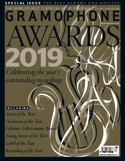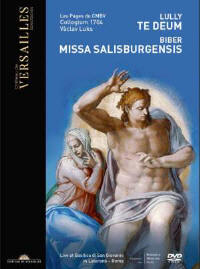Texte paru dans: / Appeared in: |
|
 |
Outil de traduction (Très approximatif) |
|
Reviewer: Richard Lawrence This performance comes not from the chapel at Versailles but from the Basilica of St John Lateran in Rome, presented by the French and Czech governments to commemorate the end of the First World War. The conductor, choir and orchestra are Czech; the children’s choir is French. Lully composed his Te Deum in 1677 for the baptism of his eldest son; it was this very piece that indirectly caused his death from gangrene when he hit his foot with a staff while directing a later performance. His scoring for strings and trumpets is bulked out here so that, for example, the symphony before ‘Te ergo quaesumus’ is assigned to recorders. The prevailing mood is, naturally, festive; but just when you think that you can’t take any more C major jollity Lully varies the mood and the key – most tellingly in the pleading section beginning ‘Dignare Domine die isto’ (‘Vouchsafe, O Lord’). The choir and orchestra perform with vigour. The soloists are not named, or, rather, not identified; all are excellent, but the bass is particularly impressive in his rhetorical passages. In the final chorus the trumpets briefly get out of sync (and the percussion – timpani and bass drum, by the sound of it – is too loud) but otherwise the ensemble can’t be faulted. Václav Luks, the conductor, has no problems of ensemble with Biber’s Missa Salisburgensis, which must have been even more of a challenge. It was composed in 1682 to mark the 1100th anniversary (not the ‘one thousand and one year anniversary’ of the translated article in the booklet) of the founding of the archbishopric of Salzburg. The ‘53-part’ scoring breaks down into double choir, soloists and six instrumental groups, but it’s certainly lavish – 10 trumpets are required – and it must have sounded glorious in the wide spaces of Salzburg Cathedral. The problem is that on film there’s no sense of the sound coming at you from all directions. What’s more, there are close-ups and long-distance views but no panning sequences, so you are denied a visual impression of the spaciousness as well as an aural one. Actually the music is not terribly interesting: ‘passus et sepultus est’, for instance, is solemn but bland. There’s an awful lot of C major trumpeting (sounding, as with the Lully, a semitone lower) and it’s a relief to get to the awestruck ‘miserere nobis’ of the Agnus Dei. Hang on at the end, and you get an encore of ‘dona nobis pacem’ and ‘Et resurrexit’, in that order. It’s a terrific performance but I think that, as they say, you had to be there. |
|




